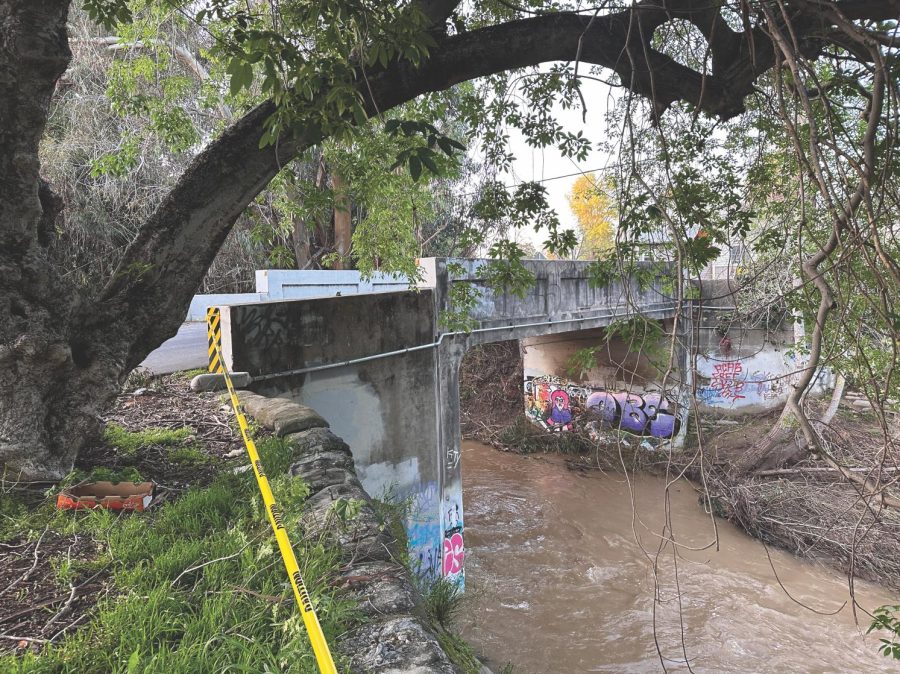Overflowing with danger
Is the city protecting us from future floods?
April 19, 2023
What can Palo Alto do to protect our city from future flooding?
Wood chips and rocks scattered across the backyard. Yard furniture strewn across the grass. This scene wasn’t unfamiliar to Palo Alto High School senior Caroline Mostofizadeh whose house was flooded by the weather in January.
The recent storms brought on flooding, power outages, and damage to the properties of many Palo Alto residents. Organizations like Youth Community Service jumpstarted the volunteer effort by filling and delivering sandbags and distributing materials for relief.
Mostofizadeh spoke to Anthro about her personal experience with the flood.
“Thankfully my mom and I prepared well by going to the Palo Alto Airport where they were providing sandbags and we filled about 120,” Mostofizadeh said. “We placed them along our house with wooden planks as well.”
When news of the impending flood first reached Palo Alto, many began panicking. Mora Oommen, executive director of Youth Community Service, a volunteer organization, quickly took action.
After hearing that the City of Palo Alto was providing sandbag materials at various locations but needed help with transportation and distribution, Oommen set out to recruit volunteers to help fill and transport sand bags.
“I realized that the need was a lot greater and it was a fairly simple process,” Oommen said. “So then the next day we sent a call out through YCS lists.”
What began as a neighborhood effort to get sandbags to the elderly and struggling residents in Oommen’s Midtown neighborhood gained momentum and became a citywide effort.
“A lot of youth came out when we put the word out that they could get service hours for it,” Oommen said. “The cities’ [Palo Alto and East Palo Alto] elected officials came out.”
Oommen says that after a time of crisis, it’s important to examine what caused and exacerbated the problem.
“I think in the moment we all can’t be pointing fingers — we all just need to roll up our sleeves and get what needs to be done, done,” Oommen said. “But I think then, we must demand answers and make sure better systems are in place to avoid such damage in the future.”
In this case, the substandard infrastructure of the Newell Bridge and Pope-Chaucer Bridge exacerbated the effects of the flood.
“Both are supposed to be renovated and fixed and elevated because there’s not enough clearance for the water to go through so that’s why there’s a lot of flooding,” Oommen said. “It’s time for community members to engage with the issue and demand action.”
According to the California Department of Transportation, the Newell Bridge has been deemed “functionally obsolete” on multiple occasions. The planning and approval process has been ongoing for the past 11 years.
It had been more than 25 years since the city of Palo Alto started discussing the reconstruction of the Newell Bridge and Pope-Chaucer Bridge; yet, Palo Alto has moved very slowly. Fixing the bridges would reduce the risk of flooding since it would increase the flow that can pass through the San Francisquito Creek, according to the San Francisquito Creek Joint Powers Authority (SFCJPA).
The project is confronting a myriad of obstacles: constant delays due to objections of residents, project reprioritization as a result of COVID, and funding challenges, with the entire project reaching a cost of $65 million from the originally estimated $47.9 million.
As a result, construction isn’t set to take place until 2024, which is a one-year delay from its previous 2023 completion date. It will take about a year and a half to complete according to the City’s website.
But with climate change creating more erratic weather patterns and events, can we wait that long before another flood flashes through?
“We as citizens can hold our elected officials, our government, and our city staff accountable for events like the recent flooding,” Oomen said. “We must demand answers and make sure better systems are in place to avoid such damage in the future.”

